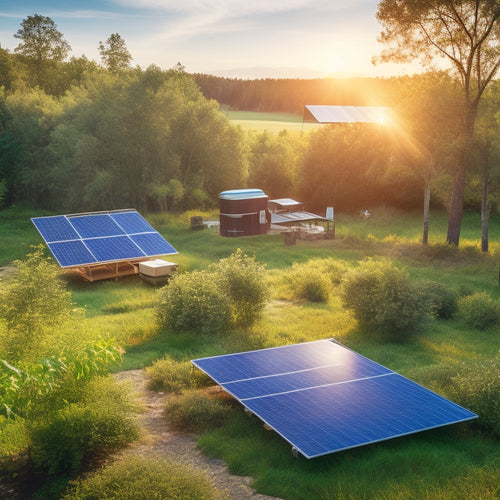
Solar Panels for Solar Farm
Share
When designing a solar farm, you need to select high-efficiency solar panels with advanced photovoltaic cell technology to maximize power output and achieve grid parity. High energy conversion rates are essential, as they enhance energy production and lead to a higher return on investment. Efficient energy harvesting through panel angle adjustments, minimal shading, and heat-resistant materials can increase energy output. Additionally, maximum power point tracking (MPPT) systems optimize voltage and current for power extraction. By understanding these key factors, you'll be well on your way to creating a highly efficient solar farm - and there's more to investigate about optimizing your project's performance.
The Essentials
- High-efficiency solar panels generate more power per unit area, ideal for limited space in solar farms and maximizing return on investment.
- Advanced photovoltaic cell technology enhances energy conversion, leading to grid parity and increased power output in solar farms.
- Maximum Power Point Tracking (MPPT) enables efficient energy harvesting, optimizing voltage and current for power extraction, and minimizing energy losses.
- High energy conversion rates guarantee conversion of maximum sunlight into usable energy, making solar farms a reliable source of renewable energy.
- Incorporation of energy storage solutions ensures a consistent power supply during low sunlight periods, enhancing the reliability of solar farms.
High Energy Conversion Rate
You're looking for solar panels that can efficiently harvest energy and maximize power output. A high energy conversion rate is essential to achieving this, as it directly impacts the amount of electricity generated by your solar farm.
By focusing on panels with high conversion rates, you'll be able to optimize your energy production and get the most out of your solar farm investment.
Additionally, photovoltaic cells with advanced technology can greatly enhance energy conversion rates, leading to increased grid parity and reduced energy bills.
Efficient Energy Harvesting
During peak sunlight hours, solar panels for solar farms must capitalize on the available energy to maximize output. You want to utilize as much renewable energy as possible to power homes, businesses, and communities. Efficient energy harvesting is essential to achieving this goal.
To optimize energy harvesting, you need to take into account several factors, including:
| Factor | Description | Impact on Energy Harvesting |
|---|---|---|
| Panel Angle | Adjusting panel angle to match seasonal sunlight patterns | Increases energy output by up to 10% |
| Shading | Minimizing shading from trees, buildings, or other obstacles | Reduces energy loss by up to 20% |
| Temperature | Using heat-resistant materials to maintain efficiency in high temperatures | Maintains energy output by up to 5% |
| Inverter Efficiency | Using high-efficiency inverters to convert DC to AC power | Increases energy output by up to 5% |
Maximum Power Output
To achieve maximum power output from solar panels, one essential aspect to focus on is the high energy conversion rate. You want to guarantee that your solar panels are converting as much sunlight into usable energy as possible. This is where power efficiency comes in – the higher the efficiency, the more power you'll generate.
Look for solar panels with high power efficiency ratings to maximize your energy output. Moreover, by incorporating advanced battery systems renewable energy storage into your solar farm, you can store excess energy generated during the day for use during periods of low sunlight or at night, assuring a consistent power supply.
When selecting solar panels, consider those with high energy conversion rates. This will enable you to generate more power per unit area, reducing the overall size of your solar farm. Additionally, high-efficiency solar panels can help you make the most of limited space, making them ideal for smaller projects.
To take your energy generation to the next level, consider incorporating energy storage solutions into your solar farm. This allows you to store excess energy generated during the day for use during periods of low sunlight or at night, guaranteeing a consistent power supply.
Increases Property Value Fast
You can expect a rapid appreciation in property value once your solar farm is up and running, thanks to the increased demand for renewable energy and the desire for eco-friendly homes.
As residential solar power systems become more prevalent, the value of properties with these systems installed will continue to rise. This enhancement in property value is guaranteed, as the presence of a solar farm is a highly desirable feature for potential buyers.
Rapid Appreciation Guaranteed
Installing solar panels on your property can catapult its value overnight, guaranteeing rapid appreciation that translates to a significant increase in your investment. As you consider utilizing the power of solar energy, you're not only contributing to a cleaner environment but also securing a lucrative return on investment. With technology advancements, the cost of solar panels has decreased, making it an attractive option for property owners seeking to enhance their property's value.
| Property Type | Average Increase in Value | Return on Investment |
|---|---|---|
| Residential | 3-5% | 10-15% |
| Commercial | 5-10% | 15-20% |
| Industrial | 10-15% | 20-25% |
As you investigate investment opportunities in solar energy, it's crucial to understand the rapid appreciation guaranteed by installing solar panels on your property. By doing so, you'll not only increase your property's value but also reap the benefits of reduced energy costs and a reduced carbon footprint. With solar panels, you're investing in a sustainable future, and your property's value will reflect that.
Boosts Local Economy
As solar farms proliferate, local economies experience a significant surge in growth, fueled by the influx of new jobs, increased local spending, and stimulated economic activity.
You'll notice an enhancement in job creation, as solar farms require skilled laborers for installation, maintenance, and operation. This influx of new workers leads to community investment, as they spend their earnings at local businesses, stimulating economic sustainability.
Renewable initiatives like solar farms also encourage local partnerships, as companies collaborate with local governments to develop infrastructure.
This infrastructure development, in turn, creates tourism opportunities, as visitors become interested in learning about renewable energy.
You'll benefit from energy independence, as local energy production reduces reliance on external power sources.
As the local economy grows, you'll see increased property values, making your investment in solar panels a wise decision.
Maximum Power Point Tracking
You need to guarantee your solar farm operates at peak efficiency, and that's where Maximum Power Point Tracking (MPPT) comes in.
MPPT enables efficient energy harvesting by identifying the best operating voltage and current of your solar panels, allowing for ideal power extraction.
In addition, a reliable home power solution, such as a solar panel battery system, can provide backup energy during outages.
Efficient Energy Harvesting
About 20% of a solar farm's energy potential is lost due to inefficient energy collection. You can't afford to waste that much energy, especially when you're investing in renewable resources like solar technology.
Efficient energy collection is vital to maximize your solar farm's output. That's where Maximum Power Point Tracking (MPPT) comes in. MPPT is a technique that guarantees your solar panels operate at their maximum power point, even when environmental conditions change.
By continuously monitoring the panels' voltage and current, MPPT adjusts the operating point to optimize energy production. This results in up to 20% more energy collected from your solar farm.
With MPPT, you can rest assured that you're getting the most out of your solar technology investment. By utilizing the full potential of your solar panels, you'll be generating more clean energy and reducing your reliance on non-renewable resources.
Optimal Power Extraction
During periods of partial shading or temperature fluctuations, solar panels often operate below their maximum power potential, resulting in significant energy losses. To mitigate this, you'll need to implement ideal power extraction techniques, also known as Maximum Power Point Tracking (MPPT).
MPPT is an essential aspect of solar technology, as it guarantees your solar panels operate at their maximum power output, even under varying environmental conditions.
By employing MPPT, you can maximize energy production and reduce losses. This is particularly important in large-scale solar farms, where even small energy losses can add up quickly.
MPPT systems continuously monitor the solar panels' voltage and current output, adjusting them to enhance energy production. This guarantees that your energy storage systems are fully employed, reducing the likelihood of energy waste.
In a solar farm, ideal power extraction is vital for maximizing returns on investment. By leveraging MPPT, you can increase energy production, reduce energy losses, and ultimately, achieve greater freedom from reliance on non-renewable energy sources.
Check Warranty and Certifications
When selecting solar panels for your solar farm, you'll want to carefully review the warranty coverage terms to guarantee you understand what's covered and for how long.
Additionally, it's crucial to take into account the energy efficiency solutions off-grid energy and renewable energy systems that the panels can provide.
You should also verify that the panels have the necessary certifications and comply with relevant industry standards, such as UL or IEC.
Warranty Coverage Terms
Your solar panel warranty serves as a safeguard against potential defects and malfunctions, providing you with financial protection and peace of mind.
It's important to understand the warranty coverage terms to guarantee you're adequately protected. The warranty duration typically ranges from 25 to 30 years, covering defects in materials and workmanship. During this period, the manufacturer will repair or replace faulty components, minimizing downtime and revenue loss.
However, it's vital to be aware of coverage limitations. The warranty mightn't cover damage caused by external factors such as weather, environmental conditions, or improper installation.
Additionally, some manufacturers may have specific requirements for maintenance and inspection to maintain warranty validity. Understanding these limitations will help you plan and budget for potential repairs and replacements.
Certification and Compliance
Certification and compliance are critical components of a solar panel's credibility, guaranteeing that the equipment meets industry standards and regulations. When you're selecting solar panels for your solar farm, you need to verify that they comply with regulatory standards. This involves checking certifications from reputable organizations, such as UL (Underwriters Laboratories) or IEC (International Electrotechnical Commission).
These certifications assure that the solar panels have undergone rigorous testing and meet specific safety and performance requirements.
You should also verify that the manufacturer has undergone compliance audits, which confirm that their quality management systems meet industry standards. Compliance audits assess the manufacturer's ability to design, manufacture, and test their products to meet regulatory requirements.
By choosing certified solar panels, you can be confident that your solar farm will operate safely and efficiently, and that you'll avoid potential risks and liabilities.
Lower Carbon Footprint Guaranteed
You can greatly reduce your carbon footprint by opting for solar panels in your solar farm, which translates to lower emissions today.
By utilizing renewable energy from the sun, you'll decrease your reliance on fossil fuels and minimize the amount of greenhouse gases released into the atmosphere.
This, in turn, will contribute to a cleaner environment and a sustainable future.
Reduced Emissions Today
Every kilowatt-hour of electricity generated by solar panels translates to a reduction in greenhouse gas emissions, making solar farms an essential component in the global effort to combat climate change.
You're contributing to a cleaner environment by choosing renewable energy over fossil fuels. With solar panels, you're reducing your reliance on traditional energy sources, which are significant contributors to pollution.
By investing in solar farms, you're supporting renewable energy policies that promote a sustainable future. These policies encourage the development and implementation of clean energy technologies, which in turn reduce our carbon footprint.
You're also supporting carbon offsetting strategies that compensate for emissions produced during the manufacturing and installation process. This means you're not only reducing emissions but also offsetting the impact of your own energy consumption.
You're taking a proactive approach to reducing your environmental impact, and that's something to be proud of.
Your commitment to renewable energy sources is paving the path for a cleaner, healthier environment – and that's freedom from the constraints of fossil fuels.
Frequently Asked Questions
Can Solar Panels Be Installed on Uneven or Sloping Land?
You can install solar panels on uneven or sloping land by using specialized installation techniques, such as adjustable mounting systems, and investing in land preparation, like grading and terracing, to guarantee a stable and efficient energy harvest.
How Often Should I Clean My Solar Panels for Optimal Performance?
Like a painter rejuvenating a masterpiece, you'll want to clean your solar panels regularly to maintain their brilliance. Aim for a cleaning frequency of every 6-12 months for peak performance, depending on environmental factors, to guarantee your solar panel maintenance stays on track.
Are Solar Panels Resistant to Extreme Weather Conditions?
You'll be relieved to know that modern solar panels boast impressive durability, with manufacturers designing them to withstand extreme weather conditions, such as hurricanes, hail, and lightning strikes, ensuring your energy independence remains unaffected.
Can I Install Solar Panels Myself to Save on Costs?
Did you know 70% of homeowners consider DIY installation to cut costs? While it's possible, you'll need electrical knowledge and adhere to local codes; otherwise, hiring a professional may be more cost-effective in the long run, ensuring a safe and efficient setup.
Do Solar Panels Generate Electricity During Power Outages?
You'll find that solar panels alone don't generate electricity during power outages, but with energy storage and grid independence, you can capture the sun's energy even when the grid is down, giving you true freedom from reliance on external power sources.
Final Thoughts
As you consider investing in a solar farm, remember that high-quality solar panels can greatly impact your project's success. With a high energy conversion rate, you'll maximize your energy production. Plus, solar panels increase property value fast, making this a smart long-term investment. Don't forget to check the warranty and certifications to guarantee you're getting a reliable product. By choosing the right solar panels, you'll not only reduce your carbon footprint but also contribute to a cleaner environment. In fact, if the world's current solar capacity were to increase by just 1%, it could power over 10 million homes.
Related Posts
-

Is This the Future of Alternative Energy Systems
Yes, alternative energy systems are shaping the future of energy. Innovations in solar and wind technologies are driv...
-

Solar Powered Lights for Sustainable Home Decor
Solar-powered lights offer a stylish and eco-friendly way to enhance your home decor. They capture sunlight, converti...
-

Top Off Grid Solar Batteries for Renewable Energy
When seeking top off-grid solar batteries for renewable energy, consider options with advanced battery chemistry, suc...


